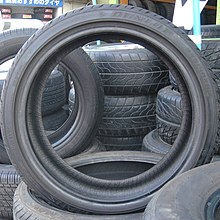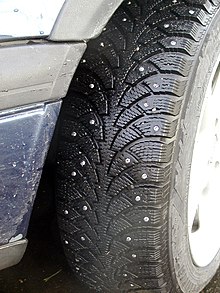









The following outline is provided as an overview of and topical guide to tires:
Tire (North American) or tyre (British) – ring-shaped covering that fits around a wheel rim to protect it and enable better vehicle performance by providing a flexible cushion that absorbs shock while keeping the wheel in close contact with the ground.
Tire Industry History
Firestone and Ford tire controversy
Types
By construction
By tread
By material
By appearance
Vehicle specific
Use specific
Components and materials
Attributes
- Camber thrust
- Circle of forces
- Cold inflation pressure
- Contact patch
- Cornering force
- Ground pressure
- Pacejka's Magic Formula
- Pneumatic trail
- Relaxation length
- Rolling resistance
- Self aligning torque
- Slip angle
- Steering ratio
- Tire balance
- Tire load sensitivity
- Tire uniformity
Behaviors
Maintenance
Inflation
- Bicycle pump
- Central Tire Inflation System
- Tire mousse
- Tire-pressure monitoring system
- Tire-pressure gauge
Tools
Life cycle
Failure
Organizations
Manufacturing Companies
Standards
- European Tyre and Rim Technical Organisation
- National Highway Traffic Safety Administration
- Tire and Rim Association
Technical
Identification
- UTQG Uniform Tire Quality Grading
Regulation and Standards
- Federal Motor Vehicle Safety Standards
- United Nations Economic Commission for Europe
- SAE J1269
- SAE J2452
See also
References
- "Regulation No 30 of the Economic Commission for Europe of the United Nations (UN/ECE) — Uniform provisions concerning the approval of pneumatic tyres for motor vehicles and their trailers". op.europa.eu. EU. Retrieved 3 October 2023.
External links
| Misplaced Pages outlines | |
|---|---|